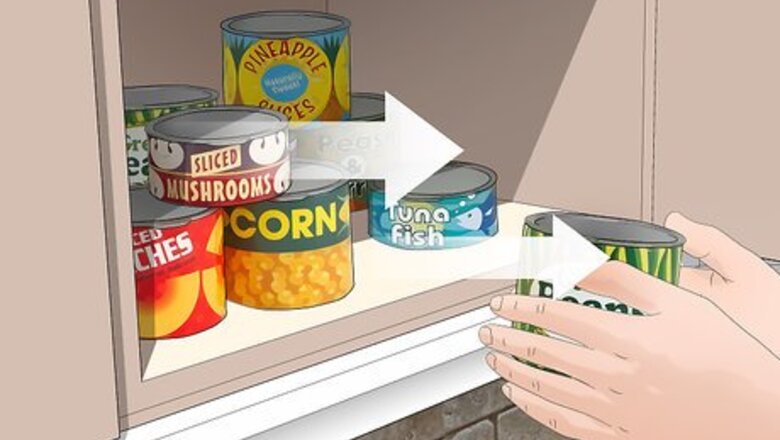
views
Sorting Your Belongings

Purge any items that you don’t need. Cluttered cabinets make it hard to find what you need. Don’t keep items that are only taking up space. When deciding if you need something, consider the last time you used it if it’s in good repair, and how many of that item you own. If you don’t know how to use the item, let it go. Pass your unused items along to a friend or donate them to a local charity. If you have a lot of items you don’t want or need, consider having a garage sale. You may have items like holiday dishes that you don’t use often but still want to keep. If you don’t have enough cabinet space to keep them in the kitchen, it’s a good idea to store them elsewhere.

Clean your kitchen from top to bottom. Dust the outside of your cabinets, appliances, and any decorative items. Use a soapy rag and clean, dry cloth to wash and dry the insides and outsides of your cabinet, as well as your countertops. Sweep and mop your kitchen floor. Wash and dry any rugs or other cloth items that you keep in the kitchen. You want to start with a clean slate! Since you're removing everything from your kitchen cabinets and drawers, this is the best time to clean them. Additionally, you don't want to put your dishes and appliances on top of a layer of dust or grime! EXPERT TIP Donna Smallin Kuper Donna Smallin Kuper Professional Organizer Donna Smallin Kuper is a Cleaning and Organization Expert. Donna is the best selling author of more than a dozen of books on clearing clutter and simplifying life, and her work has been published in Better Homes & Gardens, Real Simple, and Woman’s Day. She has been a featured guest on CBS Early Show, Better TV, and HGTV. In 2006, she received the Founders Award from the National Association of Professional Organizers. She is an Institute of Inspection Cleaning and Restoration (IICRC) Certified House Cleaning Technician. Donna Smallin Kuper Donna Smallin Kuper Professional Organizer Don't skip the refrigerator! Donna Smallin Kuper, Organizing Expert, advises: “When deep cleaning your fridge, remove everything to your counters. Also remove any removable drawers. Use an all-purpose cleaning spray and microfiber cloth to clean shelves one at a time, starting with the top shelf. Wash the removable parts in warm, soapy water, rinse and dry and return to the fridge. Then, put back the food items you took out."

Create activity zones based on how you use your kitchen. Knowing how you'll use your kitchen makes it easier to decide where to keep your items. Here are some zones you might incorporate: Coffee or Tea Spot: Place your coffee pot or tea pot in an easy-to-reach location. Store your mugs and coffee or tea nearby. Food Prep Station: Provide space to prepare your dishes. Place your cutting board, knives, measuring cups, and related items near this space. Cooking Station: You’ll likely center this area around your stove. Keep your cooking utensils nearby, as well as your oven mitt. Serving Station: If you have space, you might include a spot for serving your food. Choose an empty countertop, and keep your serving spoons nearby.

Choose easy-to-reach places for your most frequently used items. These items should be easy to take out, use, wash, and replace. Keep them at eye or waist-level near your dishwasher, sink, or stove. Don’t stack items like pots and pans if that means you have to dig to find what you want. For example, you might put the dishes you use daily in an eye-level cabinet close to the stove.

Group similar items together. For instance, your categories might include mugs, pots, dinnerware, and storage containers. Storing these items in the same spot will make it easier for you to find and grab what you need. After you have your items sorted into similar groups, check that you don’t have too many of one item. If you have more than you need, it’s a good idea to let some go.
Arranging Your Countertops
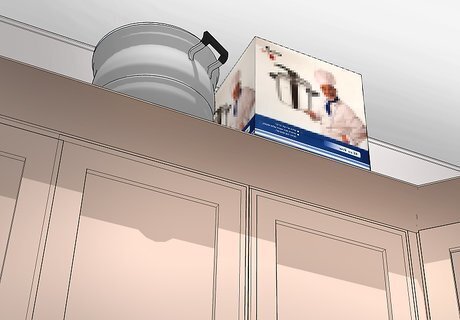
Keep rarely used items off your countertops. Place items you don’t use often inside your cabinets or store them outside your kitchen if you’re short on space. Only store items you frequently use on the countertop. This makes it easier for you to work in your kitchen every day. For example, you might keep your microwave on the counter if you use it daily, but put away your toaster if you only use it once a week. If you’re short on cabinet space, place any decorative items you’d like to display in your kitchen in an out-of-the-way location, such as on top of your cabinets. Don’t clutter your cabinets and countertops with decorations.

Place commonly used appliances and kitchenware on the counter. Designate which areas need to remain empty, such as your food prep area. Then, find a spot for items you use daily, such as your microwave, coffee pot, dish rack, and cutting board. Make sure you know where your power sockets are before you decide where to place your items. You’ll need to put your appliances in a place where they can be plugged in. EXPERT TIP Ashley Moon, MA Ashley Moon, MA Professional Organizer Ashley Moon is the Founder and CEO of Creatively Neat, a virtual organizing and life coaching business based in Los Angeles, California. In addition to helping people organize their best life, she has a fabulous team of organizers ready to de-clutter your home or business. Ashley hosts workshops and speaking engagements at various venues and festivals. She has trained with Coach Approach and Heart Core for organizing and business coaching respectively. She has an MA in Human Development and Social Change from Pacific Oaks College. Ashley Moon, MA Ashley Moon, MA Professional Organizer Organize your cabinets before tackling counter clutter. If you have messy kitchen countertops, thoroughly organize cabinets, pantries, and drawers first so things not used daily can get a proper storage home. Then, keep counters intentionally neat, just leaving out high utility appliances and decor out.

Keep your most used kitchen utensils in a jar near the stove. This includes items like your stirring spoon, spatula, spaghetti server, and slotted spoon. Only place items you use often in your utensil jar. Store items you rarely use but want to keep in a utensil drawer. A large jar or canister works great for storing your utensils. As another option, you can use a clean vase.
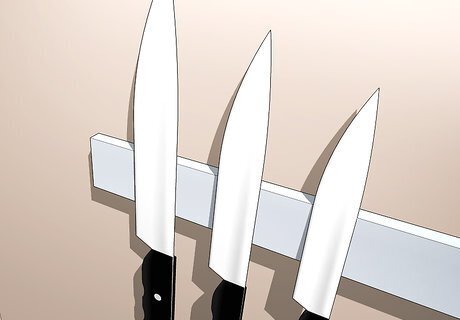
Install a magnetic strip to hang your knives. Keep only the knives you actually use, such as your chopping and paring knives. Let go of your extra knives and knife block, which can take up too much space on your countertop. If you have knives you use occasionally, store them in a drawer. Donate your unused knives and knife block.

Put a small shelf by your sink for your hand soap and sponges. A tray gives you more space around your sink. Place your soap, dish sponge, and towel on the tray. Then, place your sink stopper and bottle scrubber below the shelf. You can find an over the sink shelf for your kitchen. Alternatively, get creative and use a cake stand as a shelf!
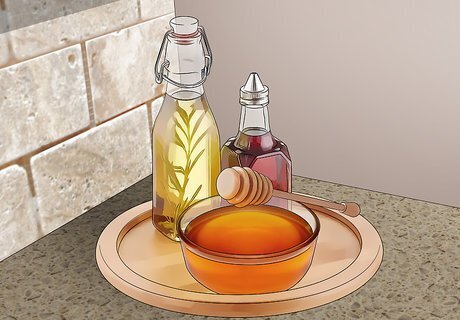
Keep items like cooking oil and honey on a dish or tray. It's normal for your oil or honey to drip, making your bottle sticky. This can gum up your cabinet or countertop and make your other items sticky! Place your oil on a small dish or tray that you can wash often.

Place fruit and vegetables in a basket or bowl on the counter. It's common to store un-refrigerated produce on your countertop. Keep your produce together by placing it in a stylish bowl or basket. Then, set it on the counter where you can easily access it. Put your fruit where you can easily grab them for a snack. If space is an issue, you might place your vegetables farther back on the counter until you need them to prepare your meals.
Organizing Cabinets and Drawers

Designate each cabinet and drawer for a specific item or items. Then, arrange your items in the cabinets and drawers. Place the items you use often near the front of your cabinets to make them easy to reach. This makes it easier to store similar items together so you can quickly find what you want. For example, you might designate a large cabinet for your dishware, a small cabinet for mugs, a bottom cabinet for pots and pans, etc. You might have one drawer for towels and pot holders, one drawer for utensils, and one drawer for extra cooking tools.
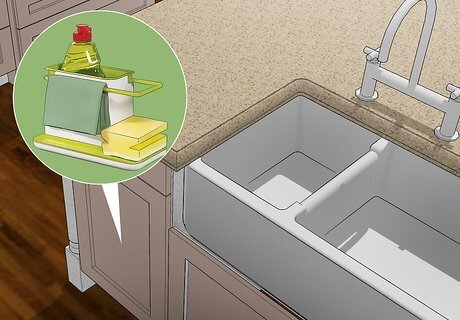
Keep your cleaning supplies under your sink. It’s easy to forget about the cabinet under your sink, but it’s the perfect place to store your kitchen cleaners. Keep your cleaning wipes, sprays, soaps, and sponges under the sink. If you need more storage space, install a shelf or decorative baskets under your sink.

Use trays with compartments to organize the contents of your drawers. Choose a tray that is the same size of your drawer or smaller. You can place your items in the tray and in the space around it, depending on what you’re keeping in the drawer. This lets you organize your utensils, measuring cups, chip clips, and other items. You can use a tray with multiple compartments or several small trays with just one compartment. Choose the solution that works best for you.

Arrange items on small, easy to remove trays to keep cabinets straight. Trays are a great solution to easily access the back of your cabinets without digging. Choose smaller trays so they are easy to remove and replace as you need items. For instance, you might use trays in your top cabinets so that the items you’ve stored in the back of your cabinets are still accessible.
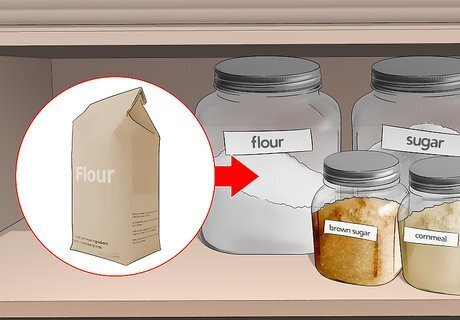
Put pantry items in clear bins to make them easy to find. Empty your foods into food storage containers to cut down on clutter and keep the pantry organized. Pour foods like cereals, grains, and baking supplies into stackable containers. Then, arrange them neatly in your pantry. Group your foods into categories. For example, stack your cereals together, your pasta noodles together, and your baking supplies together.
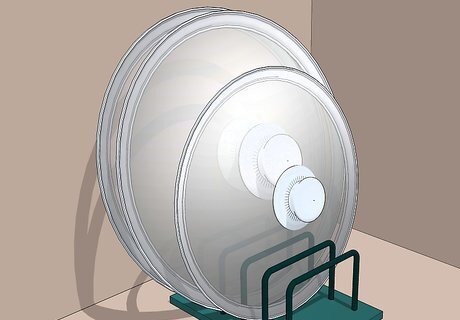
Use a file sorter or magazine holder for items like lids or baking sheets. Put the file sorter or magazine holder inside your cabinet, then put your lids or baking sheets into it. This allows you to store the items upright, keeping your cabinets uncluttered and your items within easy reach. Choose a sturdy metal file sorter so it’ll stay upright. Both plastic and metal magazine holders will work well for your kitchen storage.
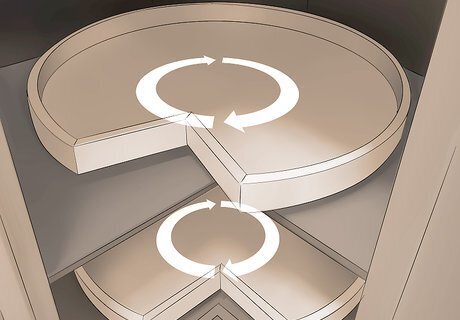
Place items on a lazy susan to avoid digging for the thing you need. A lazy susan spins, allowing you to have easy access to all of the items it contains. They come in several different sizes. You can put a lazy susan in your cabinet or pantry to store spices, canned goods, or other items. A small lazy susan works great for spices, while a larger lazy susan might be a great option for canned goods.

Keep your junk drawer clean with small, lidded containers. If you have a junk drawer, maximize its use by keeping your items sorted into smaller containers. Label the containers so you know what’s inside them. Go through your drawer regularly and get rid of the items you aren’t using.
Filling Your Refrigerator

Place ready to eat foods and drinks on your top shelf. This includes pre-packaged foods, eggs, and leftovers. The top shelf is easiest to access. Plus, storing these items at the top of the refrigerator helps prevent contamination because no foods are placed above them. Store drinks that are too tall for the top shelf on the middle shelf of your refrigerator. Avoid storing them on the door, where it's warmer.

Keep your raw meats on the lower shelf of your refrigerator. This prevents them from leaking onto your other ingredients and contaminating them. However, check over your meats to make sure they aren't leaking before you store them, as they can spread bacteria. If you find a leak, repackage your meat and clean up the spill using an antibacterial cleaner. Protect your crisper by placing your meats in a plastic container that fits on your lower shelf. If the meat leaks, it'll leak into the container, not onto your produce.

Put raw produce on the middle shelf or in the crisper. Keeping your produce on the middle shelf makes it easier to pull it out when you're ready to cook. Plus, this keeps it above the meat in your refrigerator. However, your crisper can control humidity and provide the best environment for your fruits and vegetables, so you might prefer to keep them there. If you use the crisper, make sure you don't overfill the drawers, which makes it harder to find what you need.

Keep your condiments on the door of your refrigerator. The door is the warmest part of your refrigerator, so the only safe thing to store there is your condiments. Group them according to type so it's easy to find what you need. For example, put jams and jellies together, group marinades together, and put all of your sandwich dressings in one spot.
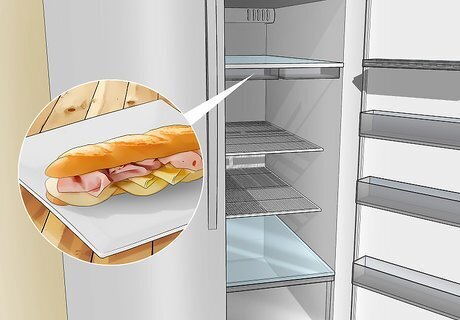
Put your cheese and lunch meats in the cheese drawer. Most refrigerators have a small drawer below the top shelf where you traditionally store cheese. If you buy sandwich meats, you can also place those in the cheese drawer. This keeps your cheeses safe and easy to find.
Creating Extra Storage Space

Use the space on top of your cabinets or refrigerator. Don’t let your vertical space go unused. Store or display items you don’t use often. Here are some ways to maximize the space you have available: Store your rarely used items, such as holiday dishes, in an out-of-the-way location like the back of a cabinet or even a garage or basement. Arrange your favorite cookbooks for a stylish storage solution. Keep your wine rack on top of your cabinets. Put your decorative items on top of cabinets or in out-of-reach locations to safely display them and dress up the space. If you have a lot of unused space at the top of your cabinets, install a shelf to allow for extra storage.

Store items on a rolling cart if you’re short on cabinet space. Opt for a stylish cart that fits your kitchen decor. Rolling carts give you more space for pantry items, cookbooks, and cooking supplies. You can also use a cart to conveniently store your coffee and tea supplies, if you’re a daily drinker. You can find a cart at your local department store, home goods store, or online.

Use an open bookshelf for easy access. A bookshelf can hold extra dishes, extra appliances, pantry items, cookbooks, and decorative items. Place your bookshelf against a wall in your kitchen or along the side of your refrigerator if space is limited. Arrange your items so that they’re visually appealing. A bookshelf is a great way to create functional decor!

Install shelves in your cabinets. Shelves are a great way to add more useable space to your cabinets. Stacking items can make it hard to get to what you need, but adding an extra shelf lets you create small stacks that are easy to access. For an inexpensive option, use collapsible plastic shelves. You can find these at a department store, home store, or online.

Put hanging hooks on walls or inside of cabinet doors. Place your wall hooks on the wall behind your stove or above your sink. Install hooks on the insides of cabinets to hold small items or items you use often. Hooks can hold pots and pans, decorations, measuring cups, towels, etc. You can use Command hooks for an easy option that won’t damage your wall or cabinet doors. If you’re going to be hanging a heavy item, like a pot, you might install a sturdier hook.
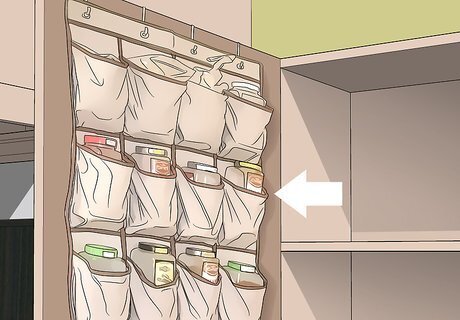
Hang an over-the-door shoe organizer on your pantry door. Use a shoe organizer on the inside of your pantry door to organize food or other kitchen supplies. The small pockets on the organizer are great for keeping track of a lot of small items. You can also add labels to the pouches if you like. This can be a great solution for people who have kids. You might place your child-friendly snacks in the shoe organizer so your child can easily grab them.
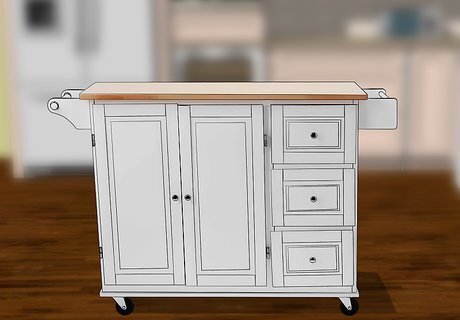
Get a mobile kitchen island for storage and counter space. A mobile kitchen island has wheels so it can be easily moved around the kitchen to suit your needs. Not only will it give you extra counter space on top, but you’ll also have space to store the items in drawers, cabinets, or open space on the lower portion of the island. Mobile kitchen islands come in different sizes and can range in price from affordable to expensive. They’re available at many department stores, as well as home improvement stores. You can also find them online.
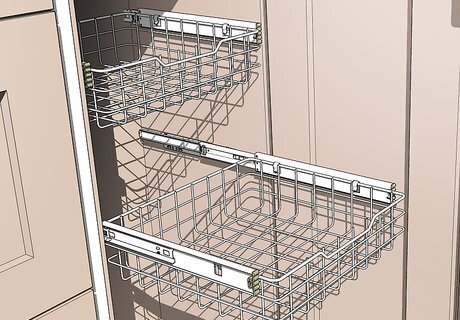
Install drawers in your bottom cabinets to maximize the space. You can find drawers designed for installation inside cabinets. Drawers will allow you to access the back of your cabinets with ease. Instead of digging in your cabinets, you can pull out the drawer and grab what you need. If you aren’t handy around the house, you might hire a contractor or handyman to install your drawers.















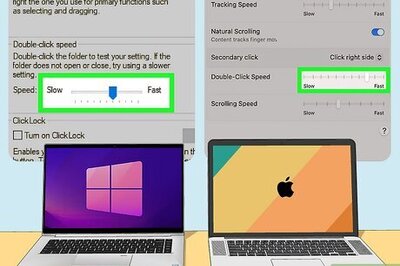



Comments
0 comment